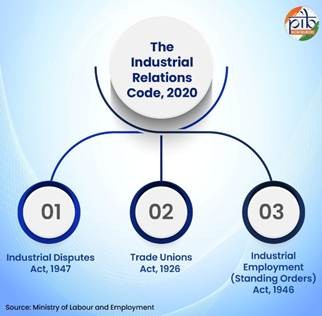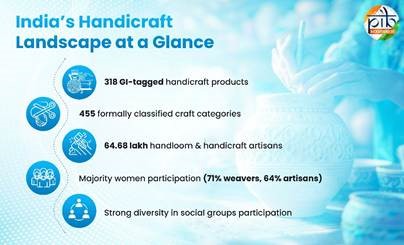



The Industrial Relations Code, 2020 streamlines and modernizes India’s labour framework by consolidating multiple laws, simplifying dispute resolution, regulating strikes and lockouts, and redefining roles of trade unions and employers. It aims to balance worker protection with industrial flexibility, reduce litigation and delays, and promote a more predictable, investment-friendly environment. Effective implementation by states, however, remains crucial for realizing its intended benefits.

Copyright infringement not intended
Picture Courtesy: PIB
National Commission on Labour highlighted a need to rationalise and simplify the exiting labour laws with an aim to protects interests of the workers. Consolidation of three existing laws viz i.e. Industrial Disputes Act 1947, Trade Unions Act 1926 And Industrial Employment (Standing Orders) Act 1946 into The Industrial Relations Code, 2020.
The IRC, 2020 consolidates and amends laws relating to trade unions, industrial disputes, and conditions of employment. It aims to promote industrial harmony by balancing worker protection with business flexibility, thereby advancing the Ease of Doing Business.
With the introduction of The Industrial Relations Code, 2020 the number of rules has been reduced from 105 to 51, number of forms from 37 to 18 and number of registers from 3 to zero, thereby reducing the overall compliance burden to spur employment.
Expanded Definition of “Worker”:
Section 2(zr) of Industrial Relations Code, 2020, the definition of ‘worker’ has been expanded to include sales promotion employees, working journalists, and supervisory employees earning up to ₹18,000 per month, thereby extending statutory labour protections to a wider segment of the workforce.
|
Pro-Labour Benefits · Extends basic labour rights to a larger workforce · Reduces income inequality and improves social security access · Ensures benefits like healthcare, sick leave, and wage protection |
Expanded Definition of “Industry”:
As per Section 2(p) of Industrial Relations Code, 2020, the term “industry” now encompasses any systematic activity carried on by cooperation between employer and worker, regardless of whether capital is invested or profit is intended, thereby bringing non-profit and low-capital activities within its ambit.
|
Pro-Labour Benefits · Brings employees in non-profit and low-capital sectors under labour protections · Expands access to conciliation and tribunal mechanisms · Strengthens collective bargaining rights · Extends statutory benefits like notice of change, retrenchment compensation, and grievance redressal |
Unified Definition of “Wages”
A single, consistent definition of wages has been applicable across all labour codes. The Industrial Relations Code, 2020 provides the 50% ceiling on exclusions to ensure that statutory benefits such as gratuity, retrenchment compensation, and social security contributions are calculated on a fair and substantial portion of actual earnings, preventing employers from artificially splitting wages to reduce obligations.
|
Pro-Labour Benefits · Ensures a substantial and consistent wage base · Enhances social security contributions, gratuity, and retrenchment benefits · Promotes transparency and reduces wage-related disputes |
Statutory recognition to the Trade Unions
Trade unions that previously lacked formal recognition now have a clear pathway to legal recognition. A union with 51% membership in an establishment can be categorised as a Negotiating Union with exclusive rights to represent workers in collective bargaining and grievance redressal. In case this threshold is not met, Negotiating Council shall be constituted comprising representatives of all trade unions with at least 20% membership.
|
Pro-Labour Benefits · Guarantees collective bargaining rights · Ensures fair representation in workplace policies · Protects unions from employer interference · Enhances industrial democracy · Strengthens job security Pro-Growth Benefits · Creates a single, clear negotiating body for employers |
Introduction of Fixed-Term Employment (FTE)
The concept of Fixed Term Employment (FTE) has been introduced, which allows engagement of workers through a direct written contract between the employer and the employee for a specified duration. Such workers are entitled to all benefits, including working hours, wages, allowances, and statutory benefits, on par with permanent employees.
It is a win-win situation for employee and employer as this provision is expected to reduce excessive contractualization and offer cost efficiency to employers.
|
Pro-Labour Benefits · Equal working conditions and statutory benefits · Eligibility for gratuity after one year · Skill development opportunities for freshers Pro-Employment & Pro-Growth Benefits · Encourages flexible hiring for seasonal and project-based sectors · Reduces excessive contractualization · No restrictions on tenure or type of work |
Revised Definition of “Strike”
To discourage flash strike and to promote industrial harmony, the definition of strike has been amended. It includes “mass casual leave also within the ambit”, which comprises of cases where casual leave has been taken by more than fifty percent of the workers on a given day.
|
Pro-Growth Benefits · Protects productivity and business continuity · Encourages negotiation before protest · Supports lawful, procedural collective action |
Decriminalisation and Compounding of Offences: The Industrial Relations Code, 2020 reduces criminal penalties for minor procedural violations and allows compounding of offences—an approach aligned with modern regulatory governance.
Case StudyMSME Compliance Relief, Maharashtra (2022) Before labour law rationalisation, MSMEs in Maharashtra reported that even minor clerical errors—such as delayed submission of Form Q or mismatch in wage registers—attracted criminal proceedings. |
Streamlined Dispute Resolution Mechanism
Time-bound adjudication of disputes has been introduced to ensure speedy disposal of the dispute. Industrial tribunals will now have 2 members (judicial and administrative member). This mechanism is in line with other tribunals and widens the experience of members. Two members Industrial Tribunal will help in speedy disposal of labour disputes. The move is pro-growth as it creates a uniform, faster, and efficient system for resolving industrial conflicts.
|
Case Study Delhi Industrial Tribunal Pilot (2021) The Delhi government ran an experimental model including an administrative member alongside a judicial member. · Disposal rate improved from 9.2 months per case → 5.3 months for industrial disputes. · Technical expertise of administrative members helped resolve wage, retrenchment and standing order cases faster. The IRC 2020 institutionalises this model nationally. |
Direct Access Mechanism to Approach the Tribunal
The concerned party may make application directly to the tribunal in the matters not settled by the conciliation officer within 90 days from the date of receipt of failure of conciliation by the party. Disputes no longer require discretionary reference by government officials, which was a time-consuming process. This reduces delays in the resolution of the industrial disputes and litigations.
Regulation of Strikes and Lockouts
For speedy resolution of disputes, to reduces conflict and to avoid abrupt stoppage of work. The Industrial Relations Code, 2020 states mandatory provisions before strike for all establishment with 14 days prior notice. Strikes are restricted during conciliation or tribunal proceedings
|
Case Study Flash Strike vs. Notice-Based Strike — Kerala Plantation Sector In 2015, plantation workers in Kerala called a flash strike during peak harvest:
In contrast, under SDF (Statutory Dispute Framework) model in 2019, when a 14-day notice was given: · Labour officer intervened in 48 hours · Settlement reached on day 9 · Zero production loss The IRC 2020 adopts the second model nationwide. |
Worker Re‑Skilling Fund: In case of any retrenchment of a worker by an employer, the employer will need to contribute equivalent to 15 days’ last drawn wages of the retrenched worker, within 45 days of retrenchment.
Increased Threshold for Lay-off, Retrenchment & Closure: The code establishes that the industrial establishment, employing 300 or more workers, shall require prior permission from the appropriate Government, for lay-off, retrenchment, or closing down its industrial establishment. The threshold has been increased from 100 to 300, with flexibility for States to enhance this limit further.
Representation of women in the Grievance Redressal Committee: The Code provides for adequate representation of women in the Grievance Redressal Committee, not less than in proportion to their presence in the workforce in the industrial establishment. Thus, ensuring gender-sensitive dispute resolution and promoting equality and safety at the workplace.
Work From Home Provision: Model Standing Orders in service sectors now explicitly allow work from home subject to mutual agreement between employee and employer. This improves flexibility, particularly benefiting women.
Threshold for Applicability of Standing Orders: To reduce the compliance burden for the establishments, the provisions relating to the requirement of certified standing orders shall apply only to industrial establishments employing 300 or more workers (previously 100) on any day in the preceding 12 months.
Digital Systems: The Code enables electronic record-keeping, registration, and communication. Digital filings and records reduce chances of manipulation and corruption, which results in transparency. Faster processing of registrations, returns, and compliance submissions improves efficiency and reduction in paper work, administrative costs, and delays, saves cost.
|
Landmark Case |
Core Issue Examined by Courts |
Key Judicial Observations |
How It Influenced the Evolution of the Industrial Relations Code, 2020 |
|
Bangalore Water Supply and Sewerage Board vs. A. Rajappa (1978) |
Scope and definition of “industry” |
The Supreme Court expanded the meaning of “industry” to include hospitals, educational institutions, NGOs, clubs, and charitable organizations, based on the triple test of systematic activity, cooperation between employer–employee, and production of goods/services. |
Highlighted the over-expansive nature of the old definition, prompting the IR Code to provide a clearer, more structured, statutory definition of “industry” to reduce litigation and ambiguity. |
|
T.K. Rangarajan vs. State of Tamil Nadu (2003) |
Legality and constitutional status of the right to strike |
Court ruled that government employees have no fundamental right to strike, and strikes cannot disrupt essential public services. |
Influenced the IR Code to introduce stringent strike regulations, including mandatory 14-day notice and prohibitions during conciliation/tribunal proceedings to ensure industrial discipline and continuity. |
|
Jaipur Zila Sahakari Bhoomi Vikas Bank Ltd. vs. Ram Gopal Sharma (2002) |
Validity of retrenchment and compliance with procedural safeguards |
Court held retrenchment without fulfilling Section 25F requirements (notice, compensation, intimation) is illegal, emphasizing strict procedural compliance. |
IR Code consolidated retrenchment, lay-off, and closure provisions under a single framework, raised the threshold to 300 for prior permission, and strengthened procedural safeguards to minimize arbitrary dismissals. |
|
SAIL vs. National Union Water Front Workers (2001) |
Regularisation of contract labour after abolition of contract system |
Court ruled that abolition of contract labour does not automatically lead to absorption as permanent employees, and government must evaluate case-by-case necessity. |
IR Code clarified provisions related to contract labour, encouraged predictable employment contracts, and supported fixed-term employment to reduce dependence on informal contract systems. |
|
Karnataka State Road Transport Corp. vs. M. Boraiah (1983) |
Applicability of standing orders and role of certified standing orders |
Court said model standing orders apply automatically until customized, certified standing orders are framed by employers. |
This led to the IR Code merging the entire Standing Orders Act into one cohesive framework and applying uniform standing orders to establishments with 300+ workers. |
|
Gujarat Steel Tubes Ltd. vs. Gujarat Steel Tubes Mazdoor Sabha (1980) |
Principles of natural justice in domestic enquiry and employee discipline |
Court insisted on fair procedure, adequate opportunity for defence, and proportionate punishment in disciplinary action. |
Strengthened the IR Code’s provisions on Grievance Redressal Committees, fair disciplinary procedures, and checks against arbitrary termination. |
|
Workmen of Dimakuchi Tea Estate vs. Dimakuchi Tea Estate (1958) |
Meaning and scope of the term “workman” |
Court held a worker must be directly linked to industrial work and clarified the criteria for classification of employees as “workman.” |
IR Code refined the definition of “worker,” included supervisory employees within a wage limit, and reduced ambiguity in categorization, minimizing classification disputes. |
|
Bidi, Bidi Leaves and Tobacco Merchants Association vs. State of Bombay (1962) |
Rights related to union formation and excessive state control |
SC held that restrictions on trade union registration must be reasonable and cannot suppress workers’ collective rights. |
IR Code adopted a more structured union recognition system, created clear guidelines for negotiating unions and negotiating councils to strengthen collective bargaining. |
|
Rohtas Industries Ltd. vs. Rohtas Industries Staff Union (1976) |
Scope of “industrial dispute” and maintainability of claims |
Court expanded the scope of disputes that can be raised by workers and reinforced the need for fair conciliation before escalation. |
IR Code introduced time-bound conciliation, direct access to tribunals after 90 days, and rationalized the types of disputes recognized under law. |
|
LIC of India vs. D.J. Bahadur (1980) |
Priority of settlements vs. statutory rules in service conditions |
Court held that settlements between workers and management remain binding unless modified through the prescribed legal process. |
IR Code clarified the legal status, duration, and binding nature of settlements and awards, making dispute resolution more predictable. |
Delayed Notification and Lack of Rules in Many States: Although Parliament passed the IRC in 2020, many States have not finalized or notified rules required for implementation. Labour is a Concurrent List subject, so both Union and State rules must be in place.
Capacity constraints in Industrial Tribunals: The shift to two-member tribunals (judicial + administrative) requires new recruitment, which many states have not completed.
Resistance from Trade Unions: Central trade unions (INTUC, CITU, AITUC) have opposed several provisions such as: 300-worker threshold for lay-offs and closure, Stricter strike notice conditions and Fixed-term employment.
“Wages” definition disputes: Despite attempts to unify “wages”, employers and HR professionals report confusion over the 50% cap on allowances, inclusion/exclusion of performance-linked incentives and impacts on PF, gratuity, and retrenchment compensation. This may increase litigation during initial years.
The Industrial Relations Code, 2020 marks a significant modernization of India’s labour regime. By integrating multiple laws, strengthening dispute settlement systems, regulating strikes, and offering flexibility through fixed-term employment and clear definitions, the Code attempts to balance worker rights with industrial competitiveness. Effective implementation, however, remains critical for realizing its promise of fostering stable, transparent, and growth-oriented industrial relations.
Source: PIB
|
Practice Question “The Industrial Relations Code, 2020 attempts to balance labour welfare with industrial flexibility.” Examine. (150 words) |
The Code aims to simplify, consolidate, and modernize existing labour laws related to industrial disputes, trade unions, and employment conditions.
It promotes industrial harmony, ease of doing business, and effective dispute resolution, while safeguarding workers’ rights.
The Code consolidates:







© 2025 iasgyan. All right reserved